The Love Triangle Spread
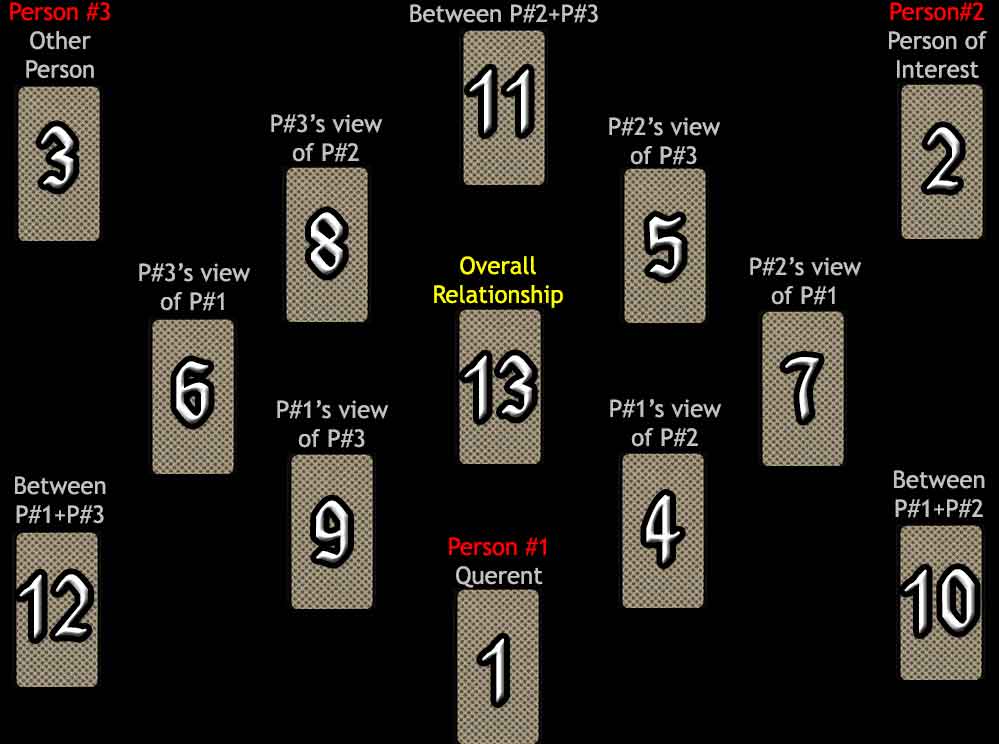
Difficulty: Complicated
Casually referred to as the Love Triangle, this spread can be used to determine the dynamics of the relationship between three people, regardless of whether romance is involved. This spread is arranged in the form of a hexagram, consisting of several large and small triangles. This tarot spread may seem somewhat complicated, but it is not entirely that difficult.
The first step is to interpret the card for each individual position in the spread. Generally, one might ask about a relationship they are involved in, but this does not have to be the case. Ordinarily, the reader's representative card is #1, their main person of interest is #2, and the other person would be #3.
The second step fills in the downward triangle and involves further examination of the individuals through their views of the other people. Each person has two more cards showing the way they see and relate to the other members of the triangle. For example, Card #6 indicates how Person #3 relates to Person #1, while Card #9 stands for Person #1's attitude toward Person #3.
The next step completes the upward triangle and the hexagram, focusing on cards #10–13. It also completes the many smaller triangles and hints at the potential for each relationship. The final card, #13 can be considered the significator of the reading, which suggests the overall potential for this three-way relationship.
Your Love Triangle Reading
| P#3 | 3to2 | 2+3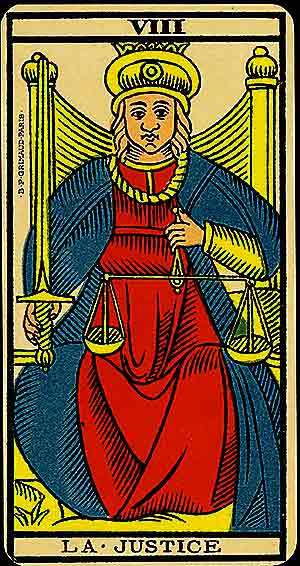 |
2to3 | P#2 | ||
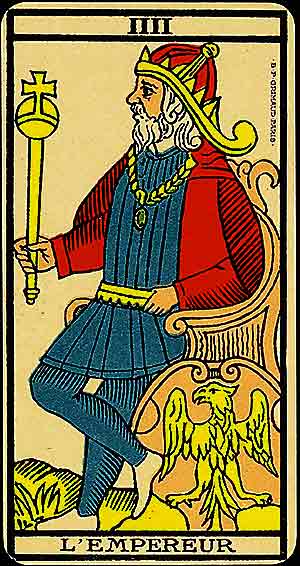 |
3to1 | 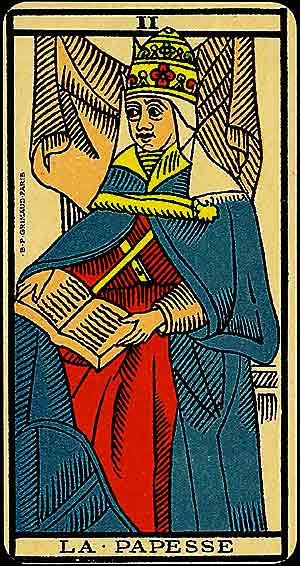 |
Overall | 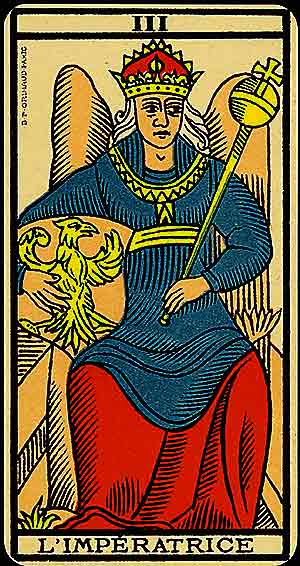 |
2to1 | 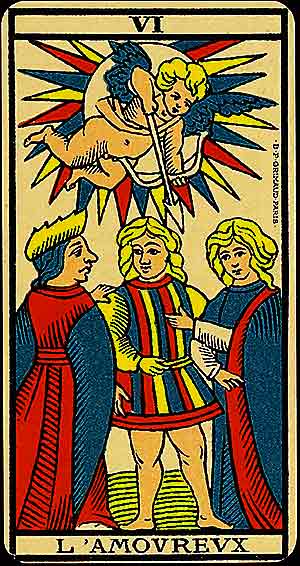 |
| 1+3 | 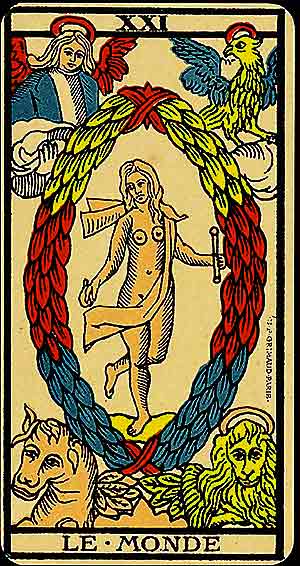 |
1to3 | 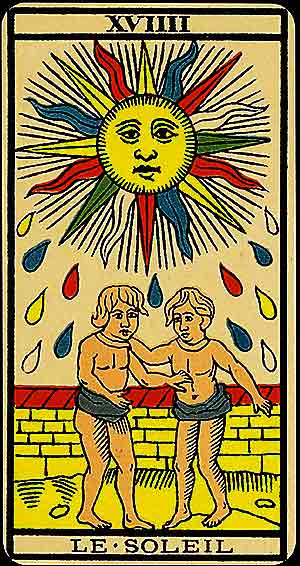 |
1to2 | 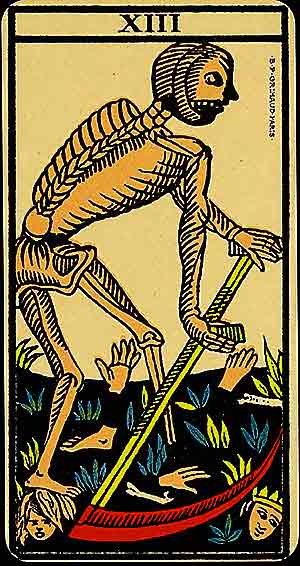 |
1+2 |
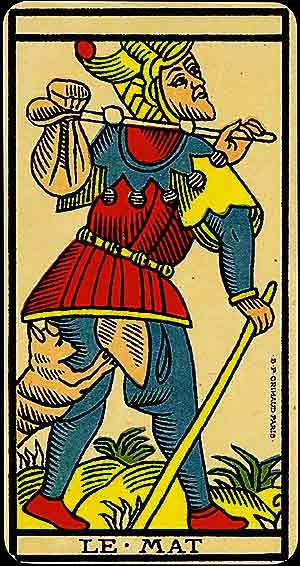 |
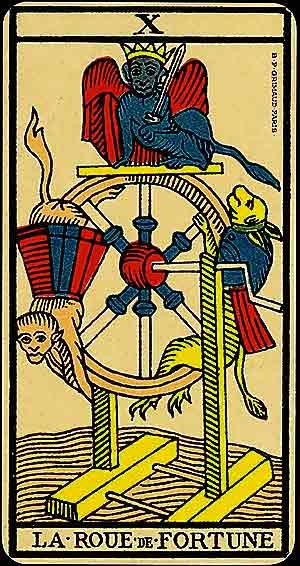 |
P#1 | 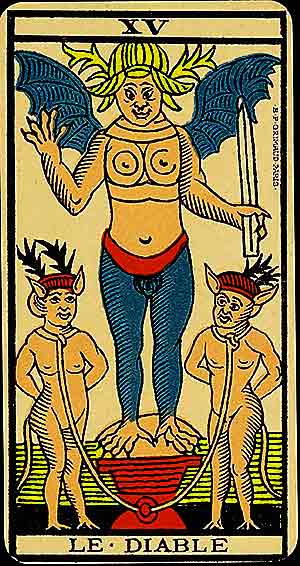 |
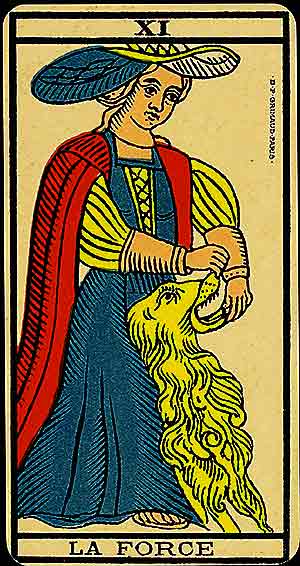 |
||
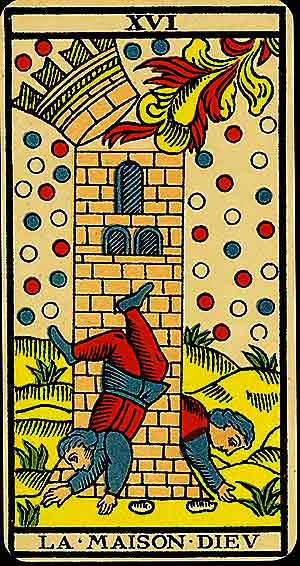 |
1: Person #1

The Tower signifies sudden upheaval, revelation, and the destruction of false structures. It is a powerful reminder that chaos and doom often precede transformation and growth.
Symbolism: A tower struck by lightning blows its top as figures fall to the ground. The lightning represents divine intervention, while the tumbling balls and figures symbolise the collapse of illusions and false foundations. The falling crown signifies the downfall of pride. Despite its dramatic imagery, the card hints at liberation and renewal.
In Relationships: A dramatic change, often revealing truths that must be addressed.
In Work: Sudden challenges or shifts that dismantle old systems. It's a chance to rebuild on a stronger foundation.
Spiritually: The Tower urges the seeker to let go of illusions and embrace the profound truth revealed in moments of crisis.
When ill-dignified: Resistance to change, denial, or clinging to crumbling structures. It warns against ignoring the signs of impending transformation.
2: Person #2

The Lovers signifies choice, connection, and the interplay between opposing forces. It represents the power of free will in aligning with one's deepest values and desires.
Symbolism: A central figure stands between two others, often interpreted as a choice between duty and desire or contrasting influences. Above, Cupid aims an arrow, symbolising divine inspiration or the fateful pull of love. The figures' expressions suggest conflict and harmony, reflecting the complexity of relationships.
In Relationships: Profound connections, romantic choices, or a pivotal decision within a partnership. It highlights emotional and spiritual harmony.
In Work: A crossroads where important decisions must align with personal values. Collaboration or partnerships may play a key role.
Spiritually: The Lovers calls for integrating dualities—earthly and divine, passion and reason—on the path to wholeness.
When ill-dignified: Indecision, temptation, or imbalance. It warns of superficial attractions or ignoring inner truth in key decisions.
3: Person #3

The Emperor embodies structure, authority, and the power of order. He is the architect of stability, encouraging discipline and leadership in the material world.
Symbolism: The Emperor's throne and square-shaped setting symbolise structure and the solid foundation of his rulership. The sceptre and orb he holds reflect his control over earthly domains. His gaze is firm and unyielding, emphasising responsibility and focus.
In Relationships: Stability, loyalty, and shared goals define relationships under the Emperor's influence. It may also indicate a partner with strong authoritative traits.
In Work: Success through organisation, discipline, and strategic planning. Leadership is both a gift and a responsibility.
Spiritually: The Emperor teaches the balance between setting boundaries and allowing the divine to flow within the constraints of the physical world.
When ill-dignified: Rigidity, stubbornness, or misuse of power. It warns against being controlling or dismissive of emotional needs.
4: Person #1's view of #2

The Devil represents temptation, materialism, and the power of the shadow self. While it warns of unhealthy attachments, it also offers an opportunity to confront and integrate the darker aspects of human nature.
Symbolism: A horned figure dominates the scene, with two smaller chained figures below, symbolising bondage to desires or fears. The loose chains suggest that this bondage is self-imposed and can be escaped. The card's imagery reflects both the allure and consequences of indulgence.
In Relationships: Obsessive or co-dependent relationships. It may indicate intense passion or unhealthy dynamics.
In Work: Temptation to take shortcuts or pursue goals at the expense of ethics. A need to reassess priorities.
Spiritually: The Devil challenges you to confront your shadow self and transform fears into liberation.
When ill-dignified: Escapism, addiction, or manipulative behaviours. It warns of being trapped in destructive patterns.
5: Person #2's view of #3

This card signifies the creative force in its most abundant and fertile form. It represents growth, nurturing, and the life-giving power of nature.
Symbolism: Her sceptre symbolises authority rooted in creativity and love, while the shield bearing an eagle emphasises vision and protection. The Empress's seated posture on her throne exudes a sensual yet controlled energy, symbolising the harmony between fertility and structure. Her crown and flowing robes represent her connection to divine beauty and earthly abundance.
In Relationships: The blossoming of love or a nurturing, supportive relationship. It is a call to cultivate affection with care and patience.
In Work: A time of prolific creativity and the manifestation of projects. Trust your ability to bring ideas to fruition.
Spiritually: The Empress guides you to honour your divine creative potential, celebrating the interplay between spirit and matter.
When ill-dignified: Overindulgence, stagnation, or excessive control. It warns against smothering growth or being consumed by material concerns.
6: Person #3's view of #1

The World is the culmination of the journey, representing fulfilment, harmony, and unity. It signifies the integration of all aspects of life and the successful completion of a cycle, opening the way to new beginnings.
Symbolism: A central figure dances within a laurel wreath, symbolising victory and wholeness. The four corners often depict symbolic creatures (the lion, ox, eagle, and man), representing the elements, the fixed signs of the zodiac, or the four faces of a cherubim. The wreath signifies completion and eternity.
In Relationships: A harmonious, complete relationship or fulfilment of long-term goals in love. It reflects unity and shared purpose.
In Work: The successful culmination of a project or phase. Recognition and achievement mark this time of completion.
Spiritually: Le Monde invites the seeker to embrace the interconnectedness of all things, celebrating unity with the divine and readiness for new journeys.
When ill-dignified: Incompletion, stagnation, or feeling unfulfilled despite external success. It warns against losing sight of the bigger picture or resisting closure.
7: Person #2's view of #1

Death signifies transformation, endings, and renewal. While often feared, this card speaks to the cyclical nature of life and the necessity of clearing away the old to make way for the new.
Symbolism: A skeletal figure wields a scythe, cutting through the remnants of the past—hands, heads, and plants alike. The barren ground reflects the stripping away of what no longer serves, while the sprouting flowers hint at rebirth and growth emerging from decay.
In Relationships: The end of a relationship or a transformative phase within one. It signals profound changes, often for the better.
In Work: A major shift, such as the end of a job or the restructuring of goals. It's a call to embrace new opportunities.
Spiritually: Death teaches the power of release and the necessity of embracing life's cycles to achieve transformation.
When ill-dignified: Fear of change, stagnation, or clinging to the past. It warns against resisting the natural process of renewal.
8: Person #3's view of #2

The High Priestess is the keeper of wisdom and the custodian of sacred knowledge. She represents introspection, patience, and the search for truths hidden beneath the surface.
Symbolism: Seated and serene, the High Priestess holds an open book, symbolising esoteric teachings and mysteries revealed through disciplined study. Her veil represents the boundary between the seen and unseen, while the calm symmetry of her setting reflects inner equilibrium and balance.
In Relationships: Emotional depth and the unfolding of hidden dynamics. This card encourages trust in intuition over appearances.
In Work: A time for reflection and strategy rather than direct action. The answers lie in careful analysis.
Spiritually: The High Priestess invites the seeker to embrace silence and meditation, revealing the wisdom that resides within.
When ill-dignified: Stagnation, secrecy, or confusion. It warns against ignoring inner guidance or withholding necessary truths.
9: Person #1's view of #3

The Wheel of Fortune symbolises the ever-turning cycles of life, fate, and destiny. It teaches the importance of adaptability and trust in the rhythms of change.
Symbolism: The wheel is adorned with figures ascending and descending, representing the rise and fall of fortunes. Its circular motion evokes the cyclical nature of existence, while divine forces implied by the card's design suggest that some aspects of life are beyond human control.
In Relationships: Changes in relationship dynamics or the appearance of new opportunities. Trust in the flow of events.
In Work: A shift in circumstances, often bringing unexpected opportunities. Stay flexible and open to change.
Spiritually: The Wheel of Fortune reflects the interconnectedness of life's cycles, encouraging surrender to the divine plan.
When ill-dignified: Resistance to change or clinging to outdated patterns. It warns of losing perspective during times of transition.
10: Overall relationship between persons #1 and #2

Strength symbolises the mastery of inner strength, courage, and the harmonisation of primal instincts with spiritual awareness. It teaches that true power lies in patience and understanding rather than brute force.
Symbolism: A figure calmly opens the jaws of a lion, symbolising the mental strength required to tame one's baser instincts. The figure's composed expression reflects confidence and inner control. The lion embodies raw energy and passion, while the gentle interaction suggests a balance between wildness and refinement.
In Relationships: Emotional resilience and understanding strengthen relationships. It may indicate a need for patience and compassion in matters of the heart.
In Work: Triumph through determination and calm perseverance. Success comes from maintaining focus and self-discipline.
Spiritually: Strength reflects the integration of instinct and higher consciousness, inviting you to connect with your inner power.
When ill-dignified: Impulsiveness, weakness, or unchecked aggression. It warns against letting fear or uncontrolled passions take the lead.
11: Overall relationship between persons #2 and #3

Justice signifies truth, balance, and the law of cause and effect. She represents the impartial hand of the universe, delivering outcomes that align with one's actions and intentions.
Symbolism: Seated on a throne, Justice holds scales in one hand and a sword in the other. The scales symbolise balance and fairness, while the sword represents the clarity and decisiveness required to enact justice. Her direct gaze emphasises accountability and integrity.
In Relationships: Honest communication and equitable partnerships. It calls for evaluating the fairness and balance within relationships.
In Work: Decisions made with integrity will lead to just rewards. It is a time to act ethically and weigh all options carefully.
Spiritually: Justice reflects the law of karma and encourages alignment with higher principles to achieve spiritual clarity.
When ill-dignified: Corruption, dishonesty, or imbalance. It warns against biased decisions or failure to take responsibility for your actions.
12: Overall relationship between persons #1 and #3

The Fool represents the untamed spirit and unshackled freedom of the soul. He wanders without boundaries, embodying movement, exploration, and detachment from worldly concerns. This card invites us to embrace change and unpredictability with courage and spontaneity.
Symbolism: The dog biting at the Fool's leg symbolises the tension between freedom and earthly constraints. His staff and bundle represent the burdens and wisdom accumulated on life's journey, carried with both carelessness and purpose. The colourful jester's attire signifies his eccentricity and adaptability, while his forward gaze reflects an openness to the unknown.
In Relationships: A new, unpredictable connection or the need for more spontaneity in existing relationships. Beware of recklessness.
In Work: Embarking on a risky or unconventional path, where intuition takes precedence over plans.
Spiritually: The Fool embodies the soul's leap into the vast unknown, trusting the divine order of chaos.
When ill-dignified: Naivety, poor judgement, or a lack of grounding. It warns of becoming aimless or distracted by superficial pursuits.
13: Overall 3-way Relationship

The Sun represents joy, success, and clarity. It is the card of illumination and vitality, promising growth, harmony, and the fulfilment of goals through clarity and connection.
Symbolism: Two children stand joyfully under the radiant Sun, surrounded by a protective wall. The Sun itself symbolises divine energy and enlightenment, while the figures reflect innocence, unity, and shared happiness. The vibrant rays evoke abundance and the thriving life force.
In Relationships: Mutual happiness, harmony, and a joyful connection. Relationships flourish under the light of clarity and love.
In Work: Success and recognition achieved through positivity and effort. It suggests a time of clarity and accomplishment.
Spiritually: The Sun calls for embracing the light within and aligning with your true purpose, radiating joy and love outward.
When ill-dignified: Arrogance, burnout, or overexposure. It warns against taking blessings for granted or letting ego overshadow gratitude.